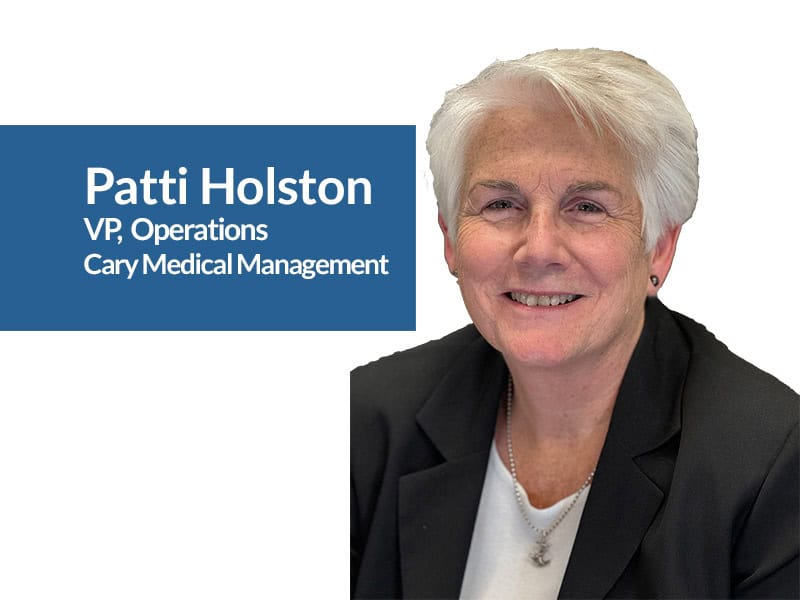Value-Based Financial Success and Survival in 2025
An in depth interview with the VP of Operations at Cary Medical Management.

Introduction – Value-Based Financial Success Strategies
As we move into 2025, we wanted to know the top-of-mind challenges and value-based financial success strategies of healthcare executives working in the trenches. Fortunately, we work with a number of executives that have extensive experience and expertise in risk-based contracts who agreed to grant us some interview time.
Our first interview is with Patti Holston, VP of Operations at Cary Medical Management, a managed services organization that oversees eight primary care clinics. Patti offered a candid look at the forces shaping healthcare today, the road ahead, and strategies for thriving in 2025.
Value-based care continues to reshape healthcare delivery, challenging providers to rethink how they deliver quality care while maintaining financial sustainability. Here are Patti’s suggested areas of focus for organizations striving to achieve value-based financial success and improve patient outcomes:
1. Reevaluate the Role of GLP-1 Drugs
Per the CDC, the prevalence of obesity among adults has reached alarming levels, with 40.3% of adults classified as obese during August 2021–August 2023. In light of this epidemic, it makes sense that GLP-1 drugs, such as Ozempic, have garnered significant attention for their effectiveness in weight loss and the associated impact on chronic disease management. However, their steep costs are creating significant financial challenges. According to KFF, a leading US health policy organization, the use of GLP-1 has increased dramatically. From 2019 to 2023, the number of GLP-1 prescriptions in Medicaid increased by over 400%, while gross spending increased by over 500%.
According to a report released in May 2024 by the Health, Education, Labor and Pensions Senate Committee titled, ‘How Weight Loss Drugs Could Bankrupt American Health Care,’ Medicare and Medicaid could potentially spend approximately $166 billion annually on weight loss drugs alone.
In addition to their extreme expense, these drugs are also not without health risks like pancreatitis, gallbladder issues, kidney issues, thyroid cancer, to name a few. It’s no wonder managing the use of these drugs was the first item on Patti’s list of priorities for 2025. “GLP-1 drugs should always be the treatment of last resort,” Patti emphasized. “Instead of prescribing immediately, providers should address the root causes of health issues, often behavioral rather than strictly medical.”
While the efficacy of GLP-1 drugs in managing weight and chronic conditions is undeniable, their cost and potential health risks underscores the need for alternative strategies that prioritize sustainable, behavior-driven health improvements. Monthly follow-ups, for instance, serve as a critical touchpoint for evaluating patient progress, offering encouragement, and addressing barriers to success. These regular check-ins provide an opportunity for physicians to personalize care plans, adjust recommendations, and hold patients accountable for their health choices. They also allow for real-time interventions, which can prevent small setbacks from derailing long-term goals.
Group sessions represent another powerful tool in combating health challenges without reliance on expensive medications. In these settings, patients benefit from peer support, shared experiences, and the collective wisdom of a community striving toward similar goals. Group settings are especially effective for addressing issues like unhealthy eating habits or sedentary lifestyles because they create a sense of accountability and solidarity. They also allow providers to efficiently disseminate education, resources, and strategies for maintaining healthy habits, reducing the need for one-on-one interventions.
Despite the effectiveness of monthly follow-ups and group sessions, physicians often face significant challenges when dealing with patients who resist behavioral modifications. Many patients may be skeptical of the effectiveness of non-pharmaceutical approaches, or they may struggle with ingrained habits, mental health challenges, or a lack of support systems. Overcoming this resistance requires a blend of persistence, empathy, and creative problem-solving. For example, providers can leverage self-management tools, such as mobile health apps, wearable trackers, or structured wellness programs, to give patients tangible ways to monitor their progress. Educating patients about the long-term benefits of behavioral changes and celebrating incremental wins can also build confidence and motivation.
“Be open to using everything that has ever worked before turning to medications,” Patti advises. Only prescribe GLP-1 drugs if the patient explicitly requests them and demonstrates a commitment to adhering to the treatment plan.”
2. Give Your Providers Permission to Say “No”
Managing patient expectations is one of the most difficult aspects of transitioning to value-based care. Unlike the fee-for-service (FFS) model, where the focus is often on the quantity of services delivered, value-based care prioritizes outcomes and cost efficiency. This shift demands a new mindset from both providers and patients—one in which accountability is a shared responsibility. However, many providers still feel pressured to accommodate patient demands, even when those demands conflict with the value-based care principles.
Patti emphasizes the importance of empowering physicians to set clear expectations and enforce boundaries. “Providers are under no obligation to continue caring for noncompliant patients if their refusal to engage in treatment jeopardizes outcomes under value-based care agreements,” she explains. This approach challenges the traditional FFS mindset, which often encourages physicians to maintain high patient volumes regardless of compliance or outcomes. In contrast, value-based care requires a more strategic allocation of resources, focusing on patients who are willing to engage and partner in their care.
Setting boundaries might involve discharging noncompliant patients back to their insurer or transitioning them to other providers who may be better suited to their needs. This is not about giving up on patients but about reframing accountability. Providers can no longer afford to bear the full burden of improving outcomes if patients are unwilling to follow care plans or make necessary lifestyle changes. By clearly communicating the consequences of noncompliance, providers create an environment where patients are more likely to take ownership of their health.
Reframing accountability also requires a cultural shift within healthcare organizations. In a FFS environment, success is often measured by the number of appointments booked or procedures performed. In value-based care, success hinges on measurable improvements in patient outcomes, preventive care, and chronic disease management. This means providers must be willing to have difficult conversations with patients, set firm boundaries, and prioritize care for those who are actively engaged.
Ultimately, this approach benefits everyone involved. Providers can allocate their time and resources more effectively, focusing on patients who are committed to achieving better outcomes. Patients, in turn, gain a clearer understanding of their role in the care process and are more likely to adopt behaviors that lead to long-term health improvements. This shift not only drives better clinical results but also ensures that healthcare organizations can thrive under value-based payment models, meeting both financial and quality goals.
3. Build a High-Value Referral Network
In value-based care, the referral network is more than a list of specialists and service providers—it’s a critical component of achieving quality outcomes and managing costs. A well-designed referral network ensures that patients receive the right care at the right time from providers who share the same commitment to delivering high-quality, cost-conscious care. Patti underscores the importance of this dynamic, explaining, “Efficiency and effectiveness are two different things. Efficiency is maximum output from resources employed. Effectiveness is achieving the goal. Care can be efficient, it can be effective, or it can be both. We’re going to have to find that intersection of efficiency and effectiveness.”
A high-value referral network must strike this balance, prioritizing providers and organizations that consistently deliver excellent outcomes while optimizing resources. These networks are essential in value-based care because they reduce the risk of fragmented care, improve patient satisfaction, and ensure financial sustainability. Unnecessary spending, such as redundant testing or avoidable hospitalizations, can be minimized when referral partners align on the goals of efficiency and effectiveness.
When building these partnerships, healthcare organizations should consider several key factors:
– Outcome Excellence: Look for referral partners who have a strong track record of achieving superior clinical outcomes, particularly in managing chronic or complex conditions. Providers with consistent performance in reducing readmissions, enhancing recovery times, and improving patient-reported outcomes are invaluable in a value-based environment.
– Cost-Conscious Alignment: Partner with specialist organizations that are committed to practicing at ‘top of license’. This means the specialist recognizes their role as a consultant to the primary care provider and is mindful of the financial implications of providing ongoing care to a patient when that care could be managed by the primary care provider These partners should also demonstrate a commitment to evidence-based practices and resource optimization, ensuring that care is delivered without unnecessary tests, procedures, or expenses.
– Commitment to Coordinated Care and Efficiency in Complex Case Management: Specialists who understand the critical need for care coordination and agree to participate in a formal collaborative arrangement with the PCP are key to the success in complex case management. Often these arrangements include an electronic system that enables the PCP to send and track referrals to the specialist, which significantly reduces the administrative burden on the clinic staff who typically make referrals via phone, and includes the ability for the specialist to send a consult note to the PCP following each patient visit. Care coordination done well can significantly improve patient satisfaction and reduce unnecessary spend. . A well-structured referral network is not just about cutting costs; it’s about delivering care that is cost-effective and cost-efficient. This means achieving optimal outcomes at a sustainable cost, ensuring that patients receive the care they need without overburdening the healthcare system. When referral partners share these priorities, the continuity and quality of care improve, strengthening the entire value-based care ecosystem.
According to Patti, “in the value-based care model, the intersection of efficiency and effectiveness is non-negotiable. Referral networks that meet this standard will be instrumental in helping organizations achieve the dual goals of improving patient outcomes and financial sustainability.” By carefully selecting referral partners who align with these objectives, providers can build a system that supports long-term success in an increasingly complex healthcare landscape.
4. Focus on Risk Adjustment
Accurate risk adjustment is essential for success in value-based care, particularly for Medicare Advantage plans, where financial survival hinges on capturing the complexity of patient populations. However, the foundation of effective risk adjustment lies in high-quality data and operational processes. Without reliable, complete, and validated data, even the most advanced coding efforts and analytics tools fall short. According to Patti, “Risk adjustment isn’t just about coding; it’s about telling the full story of a patient’s health journey.” Unfortunately, organizations face numerous challenges in achieving this, including incomplete documentation, inconsistent coding practices, and data entry errors that can undermine the integrity of risk adjustment efforts.
“From an operational standpoint, the risk adjustment process has been incredibly burdensome,” said Patti. “For years, our administrative team had to manually pull diagnosis codes from ACO and payer portals, input them into the EHR for physician review during the patient visit, and later re-enter the information from the EHR back into the payer or ACO portals. The process was not scalable. We did a cost analysis on these administrative efforts and realized it was costing us upwards of $45 per patient visit. When you’re managing thousands of patients, that adds up pretty quickly. In order for our value-based agreements to be profitable, we knew we had to streamline the process. Fortunately, we’re now using a software solution that has completely automated the process. The solution literally extracts the data from the ACO or payer portal and populates it in the patient record in our EHR. At the time of the patient visit, our providers click a button and the diagnosis data is displayed within the encounter. Once the physician confirms or rejects the diagnosis, the solution inserts it into the ACO or payer portal.”
Thriving in a Value-Based World
To succeed in 2025, healthcare organizations must adopt a proactive and strategic approach. By addressing the over usage of GLP-1s,, discontinuing therapeutic relationships with noncompliant patients,, establishing a high value referral network, and enhancing risk adjustment, they can navigate the complexities of value-based care while maintaining financial stability.
As Patti concluded, “Value-based care isn’t just about cutting costs—it’s about finding smarter ways to deliver the care that patients need while protecting the financial health of the organization. Be bold, be disciplined, and always put patient outcomes at the center of your strategy.”
Stay tuned for the next installment in our blog series, where we’ll dive deeper into strategies for building financial reserves and negotiating payer contracts in a value-based care environment.
About Patti Holston, MHA
Patti holds a B.S. in Health Care Management from UAB, a MHA from UAB at Birmingham, and is Fellow of the American College of Medical Practice Executives. Before joining Cary Medical Management, Patti served as Regional Director of Physician Practices at Healogics Specialty Physicians, where she led a team of over 100 physicians across 27 states. Her extensive experience spans various practice settings, including academic, solo and concierge, hospital-employed, private equity-based, and multiple private practices. Under her leadership, these practices consistently achieved their quality and financial objectives. Patti prides herself on “taking care of the people who take care of patients.”


